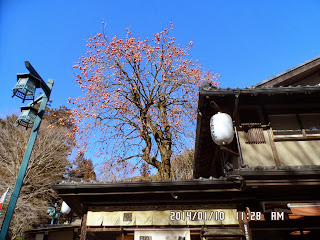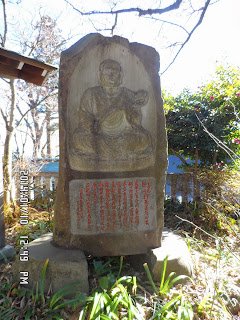Date: January 10, 2014 (Friday) Fine
Mountain: Takaosan(高尾山다카오산599m), Hachioji-shi(八王子市), Tokyo(東京都)
Transportation: JR Ofuna – Tokyo – JR Takao/Keioteito Takao – Takaosanguchi…Cable Car Kiyotaki – Takaosan
Hiking Course: Takaosan Station (Cable Car) – Observation Deck – Takosugi (Octopas Ceder) – Yakuoin (薬王院) – The Summit of Takaosan (599m) - #4 Route – Miyama Bridge – Cable Car Station - #2 Trail – Biwa Waterfall – Takaosanguchi Station (About 10 km, 4 hours)
I got “Seishun 18 Ticket” from my second son, Ryo when I came back to Ofuna from Fukushima previous day.
Ryo got the tickect from Susumu, my brother-in-law when we visited Tsuruoka from 1/1-1/4 this year.
Seishun 18 Ticket:
http://en.wikipedia.org/wiki/Seishun_18_Ticket
I wanted to utilize this ticket at most, so I decided to climb Mt. Takao in Hachioji, Tokyo.
Mt. Takao (Takaosan) is located about 1 hour train ride from Tokyo. There is a famous historical temple called “Yakuouji(薬王寺)” in the mountain.
Tengu:
http://en.wikipedia.org/wiki/Tengu
Since it was designated “Three Star Tourist Attraction” by The Michelin Guide in 2007, there are many foreign visitors as well.
It is said that there are over 2.6 million visitors to the mountain a year. The most visited mountain in the world.
I arrived at JR Takao station at 11:10 am. I changed trains to Keioteito Line and got off at Takaosanguchi(高尾山口) at 11:16.
I walked from the train station to the cable car station and took the cable car “Aoba” at 11:31.
The cable car was open in 1927. The present car was in the operation since 2008. It goes a steep slope of 31.25 degree, the steepest in Japan.
[Takaosan Station of Cable Car, ケーブルカー『高尾山』駅、케이블카 "다카오산"역]
Since I jumped in the last minute, it was jam-packed. I had to stand up but it took only 6 minutes to the top station.
When I got off the top station, I could see a good view of Tokyo from the observation deck.
There was a restaurant behind the station on a small hill. I climbed up to the hill, and there was another observation deck, naturally higher then below. I could have better views of Tokyo from this observation deck.
I saw advertisement of “Tengu-burger”at the restaurant. It was a hot-dog with an extraordinary long sausage.
It cost 500 yen, a bit expensive, but I bought it and drank “sake” with this Tengu-burger.
After taking a short break, I began strolling along the main trail to “Yakuouin” Temple.
Along the main trail, there are many interesting things, mostly religion-related things. Among them, there are statutes of great-youths which I saw at Ohyamadera(大山寺), in Kanagawa prefecture.
There are “Monkey Zoo” and “Wild Flower Garden” along the trail, but I did not go in the facilities this time.
There was a big ceder tree (450 year old) called Takosugi (octopus ceder) because its roots looked like octopus tentacles.
There were many objects related to octopus along the main trail and at the temple.
I found the funniest business related to octopus was charms named “Okuto-pasu” which means “If you put this, you will pass the exam.” “Okuto-pasu” sounds like “octopas,” hahaha.
There were many religion-related objects along the trail and within the temple.
I found many “Rokkon-seijo” objects. “Rokkon” means Six Roots: Five Roots related to five senses (sight, hearing, smelling, taste, touch) and “consciousness.”
If you have all six senses clear, you will be enlightened, and that is the most desirable state you aim through hard training.
It was a serious religious idea, I thought.
Another interesting teaching was “The Ten Commandments” in Buddhist version.
1. Don’t kill living creatures.
2. Don’t’ steel.
3. Don’t commit adultery.
4. Don’t tell a lie.
5. Don’t speak useless talk.
6. Don’t use rough words,
7. Don’t drive a wedge.
8. Don’t be greedy.
9. Don’t get mad.
10.Don’t have wrong opinion such as denying good and evil fate, the samsara, etc.)
These teaching is also worth learning, I thought.
On the other had, another interesting things I saw were the list of contributors along the trail. The names of contributors were written on wooden plates together with the amount of “seedlings of cedar” they contributed.
If they really plant so many seedlings, there would be full of ceders in Kanto Plain.
Among the names of contributors, I saw “Kitajima Saburo” the famous enka singer who contributed 100,000 seedlings.
However the contribution of "seedling of cedar" has been practiced for hundreds of years. Some cedar trees are nearly 1000 years old, not only 450 years old.
At the entrance of Yakuouin, there was “The Gate of Four Heavenly Kings” which is common in Korean temples, but rare in Japan.
There were also “Nio-mon” and many Tengu statues at the temple.
It was a mixture of a temple and mountain worship religions.
I could see many religion related businesses, besides “omikuj(おみくじfortune telling)” or “enmusubi (縁結びwishing good marriage)” as well as “passing exam charms” as “Okuto-pasu.「置くとバス」”
Karinto(かりんとう花林糖)http://en.wikipedia.org/wiki/Karinto
Aizenmhyo-ou(愛染明王):http://en.wikipedia.org/wiki/R%C4%81gar%C4%81ja
After having a sightseeing around the temple, I walked to the tral to the summit behind the temple.
It was not very far from the temple, less than 30 minute walk, I reached at the summit of Takaosan.
There was a ground-wide observation deck on the summit, and I could see Mt. Fuji clearly as well as the Tanzawa Montains.
I had a late lunch at the summit. Then began descending the mountain.
I took #4 route from the summit to the cable-car station via the suspension bridge named “Miyama Bashi.”
Then I walked across the number one route, and took number 2 route to “Biwa Waterfall.”
There were a few hikers along these trails. When I passed the Biwa Waterfall, I saw a big hotel-like building.
Later, I found it was an asylum named Tokyo Hospital.
Passing the hospital, I saw many jizo-bosatus with red aprons.
Then soon I came out to the Cable Station at the foot of Takaosan, then went back to Takaosanguchi Station. It was 3 pm.
So, my 4th hiking this year was about 10 km and 4 hour hike.
--------------------------------------------------------------------------------------------------------
分類:登山、日本、関東
登山地:東京都八王子市「高尾山(599m)」
登山月日:2014年1月10日(金)晴れ
登山口までの交通:大船~東京~高尾(JR)~高尾山口駅(京王帝都電鉄)---ケーブルカー「清滝」~「高尾山」
登山コース:ケーブル高尾山駅~展望台~タコ杉~薬王院~高尾山山頂~4号路~みやま橋~ケーブル駅~2号路~琵琶滝~高尾山口駅(10km, 約4時間)
義弟にもらった「青春18きっぷ」の有効期間が1月10日までだったので、これを利用して東京から約1時間で行ける高尾山をハイキングすることにした。
高尾山の年間の登山者数は約260万人を超え、世界一の登山者数を誇るだけあって、この日も外国人を含む大勢のハイカーでにぎわっていた。
私はラッシュアワーを避け、大船を9時過ぎの上りの電車に乗り、東京駅で中央線に乗り換えた。
JR中央線の終点の高尾駅には11時に到着。そのまま京王帝都電鉄に乗り換え1駅の高尾山口駅で下車した。
高尾山口駅から1927年に開設された高尾ケーブルカーの麓駅である清滝駅まで歩いた。
このケーブルの路線には途中、31度14分という、鉄道事業法準拠の日本の鉄道における最急勾配.地点が存在する。
車両は4代目が5年前の2008年12月に就業し、「あおば号」と「もみじ号」がある。
私が乗ったのは「あおば号」で、発車間際に乗ったため、ぎゅうぎゅうの満員でもちろん立って頂上までの6分間をしのいだが、勾配が大きく変わるため、足を踏ん張らねばならなかった。
ケーブルの高尾山駅で降りるとすぐに展望台で、東京のビル群が見える。しかし駅の後ろには一段と高い丘があり、その上にさらに展望台と無料休憩所がある。それで、丘の上の展望台に登ってみた。
無料休憩所には食べ物や飲み物が売っていたが、「天狗バーガー」と銘打ったソーセージーが驚嘆に長いホットドッグを売っていてこれをつまみに持参したポットの中の熱燗を飲んだ。
その後、1号路の表参道をゆっくりと進んで薬王院へ向かった。この参道は車も通れるような広い道で、参拝者、ハイカーたちが多い。
歩きはじめるとすぐにサル園及び野草園があったが、今回は寄らずにパス。
次に目を引いたものは巨大なタコ杉だ。このタコ杉は参道を作る時に根が邪魔なので伐採しようとしたら根が一夜にして後方に曲がり、またその姿がタコに似ているところから命名されたという。
薬王院ではこのタコにひっかけて<置くとパスする>「オクトパス」というお守りを売っていた。
また、参道沿いには大山の大山寺の参道でもみられたような「童子」の像があったが、ネットで調べると不動明王の従者で36童子だという。
また、他ではあまりみたことがない「六根清浄」の像が多々あり、修験者の信仰の山であることがわかる。
高尾山はタコ杉に限らず、杉の巨木が多いことでも有名だ。その杉の巨木の1つである『天狗の腰掛杉』の根元に、石の玉に『身』とあり、その下に『六根清浄』と書かれていた。
ちなみに六根清浄とは、人間に具わった六根を清らかにすることで、六根とは、五感と、それに加え第六感とも言える意識の根幹である
眼根(視覚)
耳根(聴覚)
鼻根(嗅覚)
舌根(味覚)
身根(触覚)
意根(意識)
のことである。(出典ウィキペディア)
[The explanation of Takaosan Tengu, 高尾山天狗の説明、다카오산 텐구의 설명]
このほか気になった看板には「十善戒」というのがあった。聖書の十戒に似ていると思った。
不殺生(ふせっしょう) 故意に生き物を殺さない。
不偸盗(ふちゅうとう) 与えられていないものを自分のものとしない。
不邪淫(ふじゃいん) 不倫をしない。
不妄語(ふもうご) 嘘をつかない。
不綺語(ふきご) 中身の無い言葉を話さない。
不悪口(ふあっく) 乱暴な言葉を使わない。
不両舌(ふりょうぜつ) 他人を仲違いさせるようなことを言わない。
不慳貪(ふけんどん) 異常な欲を持たない。
不瞋恚(ふしんに) 異常な怒りを持たない。
不邪見(ふじゃけん) (善悪業報、輪廻等を否定する)誤った見解を持たない。
(出典、ウィキペディア)
さて、参道に沿って薬王院への寄付者の名前が「杉苗料」としてずらっと掲載されている。
古いものは石碑になっていて、中には「億本」という寄付者の名前もあるが、億単位の寄付をしたのだろう。この中で私が知っている著名人の名前は歌手の「北島三郎」で彼は杉苗10万本寄付したことになっていた。
文字通りの数の杉苗を植林したら、おそらく関東平野では足らず、日本中杉だらけになってしまうなと思った。
薬王院の入り口には韓国でもよく見かける四天王の像があり、仁王像や天狗の像もあってにぎやかである。
また、人々の願いに乗じて神社ビジネスにするのはどこでも一般で、良縁祈願の「縁結び」、病気治療の「厄払い」などにかけたものが多く繰られていた。
病気治癒の現世利益を願うシンボルは「撫で木」である。これは薬王院のホームページには以下のように記載されていて、1枚200円とお買い得である。
『撫で木札とは、御本尊飯縄大権現様の御手でございます。氏名・年齢をお札に記入し、様々なお願い事の祈りを込めて高尾山火渡り祭の柴燈大護摩供の護摩木として火中に投じ、その願いを成就させる霊験あらたかな御札です。特に、お身体に病を生じている場合には、撫で木でその患部をなでさする事により、御本尊様よりお加持を賜わり、病魔を滅するご加護をいただきます。』(薬王院のHPより)
また、「お清めの塩」と称して塩も一袋100円で売っていた。この塩に関する薬王院の説明は以下の通りである。
『このお塩は、お護摩の火炎により御加持された、御本尊飯縄大権現様の菩提心(仏さまの心)を表す御浄塩で、目に見えぬ災いや、不浄を清める力が込められています。火渡りの際には、両手を胸の前に合わせてお持ちいただき、ご自身でお加持いただく事により、更なる功徳が得られます。ご自宅の四方、鬼門にあたる場所、駐車場、盛塩など、ご家庭に於いて全てのお清めに お使い下さい。』(薬王院のHPより)
Kangiten: http://en.wikipedia.org/wiki/Kangiten
登山道は薬王院を通過して山頂に続いており、薬王院の裏からの道はなだらかながら、本格的な登山道で車は入れない。
薬王院から山頂までは1km弱の距離で、山頂は開けた展望台になっていた。
ここから望む富士山は富士百景の1つといわれ、この日は良い天気で、丹沢山塊の後ろにそびえる富士山が良く見えた。
展望台のハイカー用テーブルに座り、妻に作ってもらった弁当を食べた。
下山は、4号自然研究路を歩き、まずは吊橋を渡って、表参道をクロスし、2号路をびわ滝経由で高尾山口駅へ向かった。
この道は上級者用となっていて装備の無い者は避けるようにとの注意書きがあったが、まったく危険な場所はない。利用者も少なくて快適な下山路だった。
琵琶滝を過ぎた登山路には昼なのに電球が灯った場所があったが、そこを過ぎると目の前に大きな旅館のような建物が現れた。これはどうも精神科の病院らしい。
病院の入り口をすぎるとケーブルの駅が近く、手前にはお地蔵さんがずらっと並んでいる場所があった。高尾山口駅には午後3時に到着した。
今年4回目の登山は、世界一のハイカー訪問数を誇る、“ミシュラン”三つ星観光地の高尾山だった。
I like hiking very much. I used to go hiking with a Korean hiking club named “AhToSan.” This blog introduces mostly my hiking activities in Korea and Japan, and Sydney in Australia. As of January 2020, I live in Sydney suburb. I go Blue Mountains and bush walk in Sydney area. 私は2003年から2014年まで韓国の大田(テジョン)に住んだ日本人である。11年間、週末は主に「アトサン山岳会」に参加した。14年4月に帰国したが、2020年以降はおもにシドニーで暮らし、時折、日本へ帰国する程度である。したがって最近の記事はSR(Sydney Report)としてブルーマウンテンのトレッキングを中心に書いている。
About pictures/当ブログ内の写真について/당 블로그내의 사진에 대해서
Most of the pictures in this blog are taken by my camera, yet some of them were downloaded from the website of the hiking club. If you click any pictures, they become the original size.
当ブログ内の写真の大部分は筆者のカメラで撮影したものですが、一部、山岳会の共有写真からダウンロードしたものを含みます。すべて、各写真をクリックすれば、元のサイズに拡大します。
당 블로그내 사진의 대부분은 필자의 카메라로 촬영한 것입니다만 일부 산악회 공유 사진으로부터 다운한 것도 포함합니다. 모두 각 사진을 클릭하면, 원래 사이즈에 확대합니다.
当ブログ内の写真の大部分は筆者のカメラで撮影したものですが、一部、山岳会の共有写真からダウンロードしたものを含みます。すべて、各写真をクリックすれば、元のサイズに拡大します。
당 블로그내 사진의 대부분은 필자의 카메라로 촬영한 것입니다만 일부 산악회 공유 사진으로부터 다운한 것도 포함합니다. 모두 각 사진을 클릭하면, 원래 사이즈에 확대합니다.


































































































































0 件のコメント:
コメントを投稿